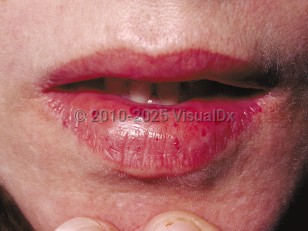Hereditary hemorrhagic telangiectasia - Nail and Distal Digit
See also in: Overview,External and Internal Eye,Oral Mucosal LesionAlerts and Notices
Important News & Links
Synopsis

Hereditary hemorrhagic telangiectasia (HHT), also known as Osler-Weber-Rendu disease, is an autosomal dominant hereditary disease (occasional cases are sporadic) causing mucocutaneous and visceral telangiectasias and arteriovenous malformations (AVMs). Several genetic forms exist: type 1 with a mutation in endoglin on chromosome 9 (ENG), type 2 with a mutation in an activin receptor-like kinase 1 gene on chromosome 12 (ACVRL1), type 3 with an as yet undefined defect, and juvenile polyposis / HHT with mutations in the gene SMAD4. The prevalence of pulmonary and cerebral AVMs is higher in type 1, while hepatic AVMs are more common in type 2. Juvenile polyposis / HHT is characterized by intestinal polyps and may also have AVMs. The most common type of HHT is type 1, followed by type 2; type 3 is rare.
HHT is a multisystem disease with most symptoms typically presenting in adulthood, in the second or third decade, and most experiencing the onset of symptoms by age 20. There is no apparent race or sex predilection. The overall prognosis is good, and most patients have a normal life expectancy.
Epistaxis is the most common and earliest sign of disease, presenting in childhood, with an average age of onset of 12 years. Telangiectasia presents later in life ranging from postpubescent years to adulthood. Telangiectasias can affect the skin, nervous system, and gastrointestinal (GI) and genitourinary tracts. Mucocutaneous lesions are seen most frequently on the face, lips, tongue, oral mucosa, and hands. Nasal and GI lesions are common. Bleeding may occur within the upper or lower GI tract and can lead to iron-deficiency anemia. Pulmonary AVMs can cause hypoxemia, pulmonary hemorrhage, shunts, and paradoxical embolic disease (eg, stroke) due to disruption in blood flow. Portal hypertension, biliary tract disease, and high-output heart failure may occur from intrahepatic shunts. Hemorrhage within the brain or spinal cord can cause significant neurologic defects and death. Paraplegia can result from spinal AVMs. The spleen and urinary tract can also be involved.
In the nail unit, subungual hemorrhages and telangiectasias may be evident.
HHT is a multisystem disease with most symptoms typically presenting in adulthood, in the second or third decade, and most experiencing the onset of symptoms by age 20. There is no apparent race or sex predilection. The overall prognosis is good, and most patients have a normal life expectancy.
Epistaxis is the most common and earliest sign of disease, presenting in childhood, with an average age of onset of 12 years. Telangiectasia presents later in life ranging from postpubescent years to adulthood. Telangiectasias can affect the skin, nervous system, and gastrointestinal (GI) and genitourinary tracts. Mucocutaneous lesions are seen most frequently on the face, lips, tongue, oral mucosa, and hands. Nasal and GI lesions are common. Bleeding may occur within the upper or lower GI tract and can lead to iron-deficiency anemia. Pulmonary AVMs can cause hypoxemia, pulmonary hemorrhage, shunts, and paradoxical embolic disease (eg, stroke) due to disruption in blood flow. Portal hypertension, biliary tract disease, and high-output heart failure may occur from intrahepatic shunts. Hemorrhage within the brain or spinal cord can cause significant neurologic defects and death. Paraplegia can result from spinal AVMs. The spleen and urinary tract can also be involved.
In the nail unit, subungual hemorrhages and telangiectasias may be evident.
Codes
ICD10CM:
I78.0 – Hereditary hemorrhagic telangiectasia
SNOMEDCT:
21877004 – Hereditary hemorrhagic telangiectasia
I78.0 – Hereditary hemorrhagic telangiectasia
SNOMEDCT:
21877004 – Hereditary hemorrhagic telangiectasia
Look For
Subscription Required
Diagnostic Pearls
Subscription Required
Differential Diagnosis & Pitfalls

To perform a comparison, select diagnoses from the classic differential
Subscription Required
Best Tests
Subscription Required
Management Pearls
Subscription Required
Therapy
Subscription Required
References
Subscription Required
Last Reviewed:01/19/2021
Last Updated:01/17/2022
Last Updated:01/17/2022
Hereditary hemorrhagic telangiectasia - Nail and Distal Digit
See also in: Overview,External and Internal Eye,Oral Mucosal Lesion
